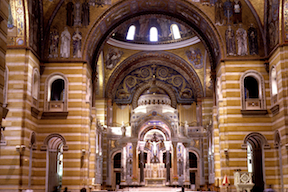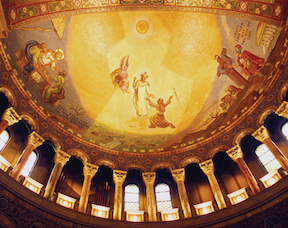
THE CATHEDRAL BASICA OF ST. LOUIS

Romanesque on the outside, Byzantine on the inside, the New Cathedral has to be acknowledged along with the Gateway Arch as one of the two greatest architectural and artistic masterpieces in St. Louis.
The cathedral’s existence can be attributed to the vision of Archbishop John Glennon. In February, 1905, Glennon took his sermon text from the first chapter of Kings: “I propose to build a temple in the name of the Lord my God.”
When Glennon was invested as a bishop three months later, Archbishop John Ireland of St. Paul told him to “Build your cathedral!” Ireland said that the city of St. Louis “demanded a cathedral worthy of its own past and of its future—towering high to the skies, as towers the historic eminence of Saint Louis.”
The New Cathedral more than fulfills Ireland’s words. The most noted architects of the United States and Europe were invited to submit designs and many did. However, when it was time for Archbishop Glennon and the committee to make their choice, they stayed close to home. The St. Louis firm of Barnett, Haynes and Barnett was selected in 1906, just two years after they had produced the Palace of Liberal Arts at the World’s Fair.
The groundbreaking was held on May 1, 1907, and construction continued until 1914. The Cathedral wasn’t truly completed, however, until the last of the mosaics were installed in 1988. And it is the mosaics above all else that are the glory of this church.

Color abounds upon entering the main body of the church. Its vastness is awe-inspiring—the distance from the door to the high altar, the height of the three domes that hover above the floor (the number of feet to the top of each dome is imbedded into the marble floor directly beneath them).
The first dome features a mosaic of the great seal of the Archdiocese of St. Louis, as well as the history of Catholicism in the area. Here you’ll find mosaics of Ste. Philippine Duchesne, Fathers Marquette and DeSmet and the first mass and baptism in the city. Other sections honor the works of charity done by the religious orders, including teaching the young people. Cardinal Ritter’s effort to desegregate St. Louis’ parochial schools is also highlighted.
It is 143 feet to the top of the great central dome, painted in brilliant red with mosaic panels depicting the Holy Trinity, Ezekiel the Prophet, Elias in his chariot and many angels and archangels. Mosaics on the arches show God the Creator, Jesus as teacher, the Holy Spirit as Sanctifier and the Last Judgment.
The last mosaics installed were those on the transepts east and west of the central dome. The one on the east portrays Christ’s resurrection. The mosaic on the west is done in strong colors and shows the Pentecost, when the Holy Spirit descended on Christ’s apostles and inspired them to go out and preach His word. Mary Reardon of Hingham, Massachusetts was the artist for these mosaics, and they are clearly different from all others in the church as they are more modern in design. To me they’ve never quite fit with the rest.
The 12 apostles are portrayed in the mosaics on the sanctuary dome, which floats above the dome of the baldachino, the marble canopy which crowns the high altar. It is worth a trip to the New Cathedral just to see the altar and sanctuary. The colors of the mosaics and the marble are brilliant and inspiring. Walk behind the altar to see the Bishops’ Hall, featuring Italian mosaics showing the coats of arms of the men who have served the St. Louis archdiocese as bishops and archbishops.
In addition to the main body of the church, there are two chapels on each side. The ones on the left of the altar were designed by Tiffany & Company. The All Saints Chapel is toward the rear; the Blessed Virgin’s Chapel at the front. Visitors will notice that the mosaics here are unlike the others displayed throughout the cathedral. These are Italian mosaics, and the process used to install them is very different from the Byzantine method. They have a flatter look to them in terms of brilliance and sparkle, but they also are made of softer colors which give these two chapels a warm feeling.
The Blessed Sacrament Chapel toward the front on the east side of the cathedral houses the tabernacle. That makes it the most sacred of the chapels, and it is reserved for private prayer. Mosaics depict the Eucharist and the suffering of Christ. All Souls Chapel is the darkest in the cathedral. Black marble symbolizes death, and white the resurrection. The mosaics on the ceiling are reminiscent of motifs that might have been used in Native American weavings.
The mosaics here, as in most of the church, are in the Byzantine style. A small museum in the lower level of the cathedral showcases the mosaicist’s art, particularly the work of Paul and Arno Heudeck. This father and son are responsible for the installation of 90 percent of the cathedral’s mosaics. Arno was dying of cancer as he finished the last mosaic, but he made sure that his life’s work was completed.
Byzantine mosaics are made of tiny pieces of molten glass. The mosaicist creates a “cartoon” or drawing of the design to be installed. Although he didn’t do the original artwork, the mosaicist is the one who chooses the colors of the mosaic. He is always working in reverse, pasting the tiny pieces of glass onto paper that is pressed onto a fresh layer of cement mortar. Once the pieces adhere to the cement, the paper is removed.
Gold is the dominant color in Byzantine mosaics. The gold leaf and other colors catch the light because pieces of glass have jagged edges and the mosaicist uses a small, pointed hammer to tilt them, creating a shimmering effect when the light hits them.
Of the mosaics in the Cathedral Basilica of St. Louis, Father Maurice McNamee, who was a Professor of Language and Art at St. Louis University, stated: “It is no exaggeration to say that no comparable mosaics of this quality and quantity exist anywhere in the Western Hemisphere.”
Archbishop Glennon became St. Louis’ first Cardinal late in his life, much later than many would have expected. He was in his 80s when he went to Rome to receive the red hat in 1946. St. Louis prepared a triumphant homecoming for its beloved prelate. However, when Cardinal Glennon came home to his cathedral, it was for his funeral. He died in Ireland while on the return trip from Rome. The streets were filled with mourners instead of celebrants. His crypt is in the Mosaic Museum at the Cathedral beneath the All Souls Chapel.
Cardinal Glennon’s legacy is the cathedral he built. It was granted basilica status by Pope John Paul II in 1997, making St. Louis one of the few cities in the world to have two churches so designated. One hundred years ago this remarkable structure was just about to be born. Today it stands as a symbol of the glory of God and the creative genius of man to inspire all.
The Cathedral Basilica of St. Louis is located at 4431 Lindell Boulevard east of Forest Park. Obligation masses are Saturday at 5 p.m. and Sunday at 8 a.m., 10 a.m., noon and 5 p.m. The church may be visited from 7 a.m. to 5 p.m. daily. Tours may be arranged by calling 314-373-8242. The Cathedral Shop and Mosaic Museum are open from 10 a.m. to 4 p.m. Monday-Saturday and from noon to 4:00 pm on Sunday. For information on Cathedral concerts, featuring world class musicians and vocalists, call 314-533-7662 or visit www.cathedralstl.org.
